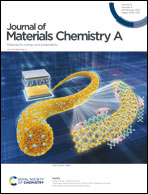Two-dimensional metal–organic framework with perpendicular one-dimensional nano-channel as precise polysulfide sieves for highly efficient lithium–sulfur batteries†
Abstract
Although they are regarded as one of the most promising energy storage devices, lithium–sulfur batteries still suffer from severe “shuttle effects”, which limit their further applications. In this work, a unique two-dimensional metal–organic framework with a small perpendicular one-dimensional channel (5.2 Å) was prepared and employed as a highly efficient ion sieve to suppress notorious “shuttle effects” in Li–S batteries. The thin but closely packed laminar-like 2D CuBDC sheets could effectively suppress the shuttle of polysulfides and cause facile transport kinetics of the lithium ions during cycling. Consequently, after use as a functional separator in an Li–S battery, a capacity of 830 mA h g−1 at 1 C was obtained after a long cycling period of 1000 cycles. The excellent capacity of 795 mA h g−1 could still be obtained when cycled at 0.5 C after 500 cycles under a high sulfur loading of 5.2 mg cm−2, suggesting the superb polysulfide sieving ability of 2D CuBDC sheets.



 Please wait while we load your content...
Please wait while we load your content...